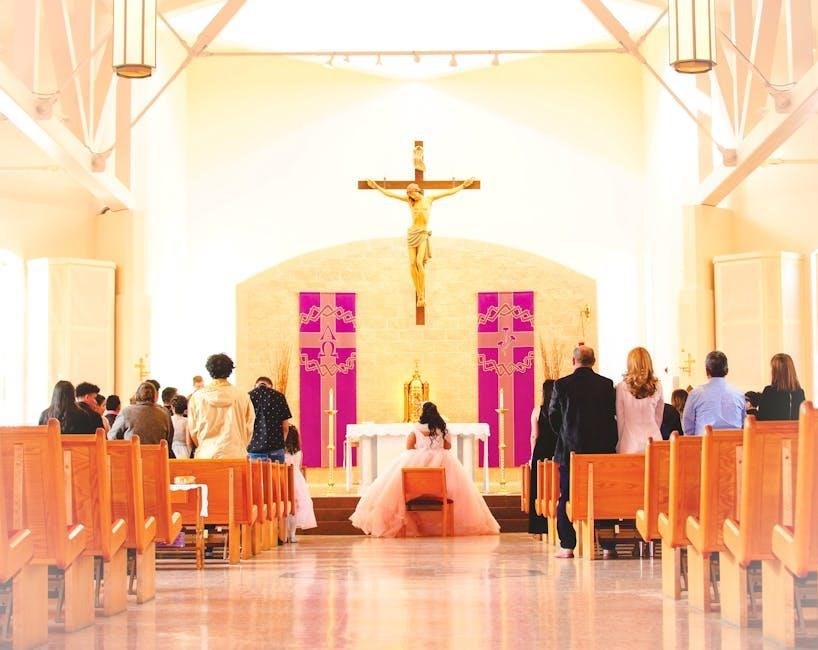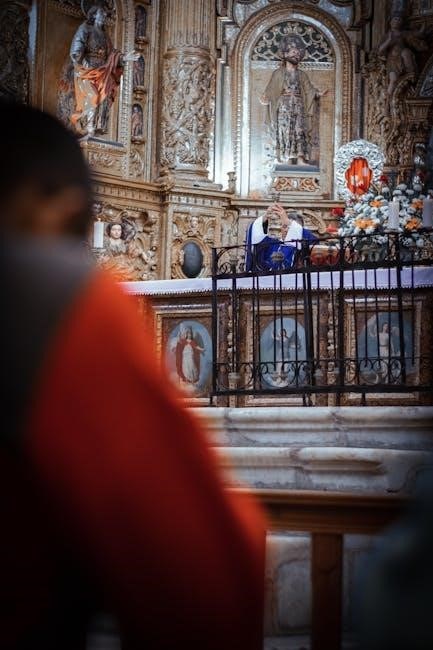The Traditional Latin Mass (TLM) Calendar 2023 provides a structured guide to the liturgical year, highlighting feast days, saints, and solemnities. It aids Catholics in participating deeply in the Extraordinary Form, fostering devotion and spiritual growth.
Overview of the TLM and Its Significance in 2023
The Traditional Latin Mass (TLM) remains a cornerstone of Catholic worship, offering a timeless and deeply spiritual experience. Its significance in 2023 lies in its ability to connect modern faithful with centuries-old traditions, fostering a sense of continuity and reverence. The TLM emphasizes sacred liturgy, preserving the richness of Catholic heritage. Many Catholics find profound spiritual nourishment in its structure, which includes the use of Latin, Gregorian chant, and traditional rituals. In 2023, the TLM continues to attract those seeking a more contemplative and reverent form of worship. Its enduring appeal highlights the importance of maintaining liturgical traditions in a rapidly changing world. The TLM also serves as a unifying force, bringing together diverse communities through shared devotion and prayer.
Structure of the Traditional Latin Mass
The Traditional Latin Mass is divided into the Ordinary (unchanging prayers) and Proper (varying with feast days). Its structure includes the Introit, Kyrie, Gloria, Epistle, Gospel, Offertory, Consecration, and Communion.

Key Components of the TLM: Ordinary and Proper
The Traditional Latin Mass (TLM) is composed of two main parts: the Ordinary and the Proper. The Ordinary includes prayers and chants that remain constant throughout the year, such as the Kyrie Eleison, Gloria in Excelsis, Credo, Sanctus, and Agnus Dei. These texts are central to the liturgy and are recited or sung at every Mass. The Proper, however, varies depending on the feast day or season, with specific Introits, Collects, Epistles, Gospels, Offertories, and Communions. This structure ensures a balance between continuity and diversity, allowing the faithful to experience the richness of the liturgical year while maintaining the timeless essence of the TLM.

Liturgical Calendar for the TLM in 2023
The 2023 TLM Calendar outlines the liturgical year, featuring feast days, saints, and observances. It includes key seasons like Advent, Christmas, Lent, and Easter, guiding Catholics through traditional worship.
Understanding the Ranking of Feast Days and Their Observance
The Traditional Latin Mass (TLM) Calendar 2023 organizes feast days into a hierarchical structure, with classifications such as Doubles, Semidoubles, and Simplex. These rankings determine the liturgical precedence and the specific rituals observed. Doubles, the highest rank, include major solemnities like Christmas and Easter, often marked with octave celebrations. Semidoubles are slightly less prominent but still significant, such as certain saints’ days. Simplex feasts are the least solemn and may be commemorated with minimal ceremony. This ranking system ensures a balanced and structured approach to worship, guiding the faithful in their devotion throughout the liturgical year. It reflects the rich tradition and theological importance of each observance in the Catholic faith.
The Role of Saints’ Days and Their Significance
Saints’ Days hold a profound place in the Traditional Latin Mass (TLM) Calendar 2023, honoring the lives and legacies of holy men and women who exemplified extraordinary virtue. These feast days serve as reminders of the saints’ intercession and their role as models for Christian living. The Church emphasizes these days to inspire devotion, foster imitation of their virtues, and seek their spiritual aid. Each saint’s day is celebrated with specific Mass propers, highlighting their unique contributions to the faith. This liturgical commemoration strengthens the bond between the faithful and the communion of saints, while also enriching the spiritual life of the Church. Their stories and feast days are integral to the TLM’s liturgical tapestry.

How to Use the 2023 TLM Calendar PDF
Download the PDF, subscribe to its digital version, and integrate it with tools like Google Calendar. This allows easy tracking of feast days and Mass schedules.
Steps to Download and Utilize the TLM Calendar effectively
To effectively use the 2023 TLM Calendar PDF, start by downloading it from a trusted source, such as an official Catholic website or a reputable traditional Latin Mass organization. Once downloaded, open the PDF and familiarize yourself with its layout, which typically includes feast days, Mass readings, and liturgical instructions. For digital convenience, subscribe to the calendar using iCalendar or Google Calendar by copying the provided URL. This allows syncing with your personal devices, ensuring reminders for important dates. Additionally, print the PDF for physical use, especially for personal devotion or parish distribution. Regularly check for updates to stay informed about any changes or newly added feast days. By integrating the TLM Calendar into your daily routine, you can deepen your spiritual practice and stay connected to the liturgical life of the Church.
Integrating the TLM Calendar with Digital Tools
Integrating the Traditional Latin Mass (TLM) Calendar 2023 with digital tools enhances accessibility and convenience for followers. Begin by downloading the calendar in a compatible format, such as an .ics file, which can be easily imported into digital calendar applications like Google Calendar or Apple Calendar. This allows for seamless synchronization across multiple devices, ensuring that important feast days and liturgical events are always accessible. Setting reminders for significant dates helps users stay informed and engaged. Additionally, sharing the calendar with others, such as parish groups, fosters community participation. For a more enriched experience, consider integrating the TLM Calendar with prayer apps or devotionals that offer daily Mass readings or prayers, aligning your digital tools with your spiritual practices. Regularly updating the calendar ensures accuracy and relevance, maintaining the integrity of the liturgical cycle while embracing modern technology for a holistic and connected experience.
Prayers and Devotions Associated with the TLM
The TLM is enriched with traditional prayers and devotions, such as the Rosary and litanies, fostering a deep spiritual connection. These practices, rooted in centuries of Catholic tradition, emphasize the intercession of saints and the pursuit of holiness, aligning perfectly with the liturgical cycle outlined in the 2023 TLM calendar.
Common Prayers Recited During the TLM
The TLM is accompanied by timeless prayers that reflect deep devotion. The Confiteor, a penitential rite, expresses sorrow for sins. The Gloria Patri honors the Trinity, while the Ave Maria and Pater Noster are central to the Liturgy of the Eucharist. The Agnus Dei and Nicene Creed are also integral, emphasizing unity and faith. These prayers, rooted in tradition, foster a profound connection to the sacred liturgy and the mysteries of the faith.

The Role of the Priest in the TLM
The priest plays a central role in the TLM, serving as the mediator between God and the faithful. He offers the Holy Sacrifice, leads prayers, and ensures the liturgy’s integrity, fostering devotion through his sacred ministry.
Preparation and Rituals for Celebrating the TLM
The priest’s preparation for the TLM involves meticulous rituals, ensuring the liturgy’s sanctity. He begins with the Asperges, blessing the congregation with holy water. The Prayers at the Foot of the Altar are recited, emphasizing purification and devotion. The priest dons traditional vestments, symbolizing his role as a mediator. The Mass follows a structured order, with the Ordinary and Proper prayers, chants, and gestures performed with precision. The Offertory prepares the gifts, and the Consecration is the pinnacle, reenacting Christ’s sacrifice. The priest’s reverence and adherence to tradition foster a contemplative atmosphere, deeply connecting the faithful to the sacred rites.
The Traditional Latin Mass (TLM) Calendar 2023 serves as a vital tool for Catholics seeking to deepen their spiritual lives through the Extraordinary Form. By outlining the liturgical year, it provides clarity and structure, enabling faithful participation in feast days, solemnities, and devotions. The calendar fosters unity among Traditional Latin Mass communities worldwide, ensuring continuity with the rich liturgical heritage of the Church. It also aids in the spiritual formation of the faithful by highlighting the importance of saints and their intercession. For those dedicated to the TLM, the 2023 calendar is not just a schedule but a spiritual guide, helping to integrate the sacred rhythms of the liturgy into daily life.